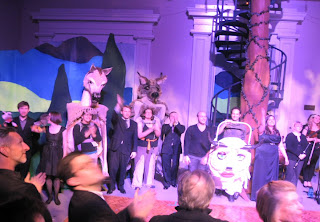Bourbon Baroque and Squallis Puppeteers present
Les Sauvages
Review by Anna Blanton
Entire contents are copyright © 2012 Anna Blanton. All rights reserved
On Friday night I attended Les Sauvages presented by Bourbon Baroque in collaboration with Squallis Puppeteers. Les Sauvages was written by Louis Fuzelier and Jean-Philippe Rameau as an extra divertissement – a short performance, typically a ballet, that is presented as an interlude in an opera or play – for the March 10, 1736, performance of the opera-ballet Les Indes Galantes (1735).
The concept of turning Les Sauvages into a puppet opera was the brainchild of John Austin Clark and Nicolas Fortin, artistic directors of Bourbon Baroque. The simple, rustic plot and small amount of singers required made Rameau and Fuzelier’s work ideal for a puppet opera. Squallis Puppeteers would be the perfect candidate for Bourbon Baroque to team up with due to their knack for bringing larger-than-life characters to life in the form of puppets. During the early stages of this project, Squallis and Bourbon Baroque decided to add an extra twist by making the characters animals.
 |
Damon (puppeteer Zach Brammel) from Les Sauvages. Photo by Anna Blanton. |
There are four main puppet characters in Les Sauvages: a white buffalo named Zima, a coyote named Adario, a Spanish stallion named Don Alvar and a French peacock named Damon. The synopsis for the play is your typical love story. Adario, the coyote (Nora Christensen), is in love with Zima, the white buffalo (Shawn Hennessey). Don Alvar, the Spanish stallion (Stella Christensen), and Damon, the French peacock (Zach Brammel), are also in love with Zima. For reasons of her own, Zima rejects Damon and Don Alvar, and Adario and Zima run off together and live happily ever after.
In Elizabeth Kramer’s February 19 Courier-Journal article, Squallis puppeteer Shawn Hennessey said, “This is the most complex thing I’ve ever made, and it’s probably one of the most complex puppets for Squallis.” I could definitely believe that statement after seeing the puppets on stage. Each of the main characters was at least ten feet tall and was operated by one person inside the puppet. The designs were absolutely beautiful. I was very surprised and impressed to find out that the four main puppets were produced from mostly donated and recycled materials. From examining the puppets up close after the performance, the makers appeared to have used a variety of different techniques, including sewing, paper-mache and some impressive engineering skills. Each of the puppets had moving mouths and appendages. The two features that stood out the most were the peacock puppet’s tail plumage, which was stunning and vibrantly colored, and the ability of the buffalo to kick up her hind legs. The ingenuity displayed by the Squallis Puppeteers was exemplary.
The fine puppetry craftsmanship was complimented by Bourbon Baroque’s exquisite accompaniment. The entire ensemble was tight and had great energy. The ensemble displayed great precision playing and clarity that I have not heard in Louisville with any musical ensemble in a long time. The quick passages were in perfect unison down to the trills. I also enjoyed the authentic baroque sound with the use of baroque instrumentation, styling and tuning. The strings used little or no vibrato, giving the tone a very pure, clean sound. The dynamic changes and swells were achieved with great finesse in regards to the string player’s bowing technique.
For those who may have not noticed, the orchestra was tuned to an A415 pitch, or an A-flat. Historically there were many different pitches to which a group of musicians tuned, based on local tradition or, in the baroque era, to the pitch the local organ was set, as it was impractical to tune otherwise. This pitch varied from about A=392 Hz in Italy to as high as A=465 Hz in France, according to Nicolas Fortin. The A415 has become the pitch standard for baroque music. The A415 also gives the ensemble as a whole a darker, warmer sound. The A440 standard we are used to today did not become universal until the 20th century.
The lead vocalists and chorus were also highly skilled and sounded great. Teresa Wakim, soprano, stood out with her suppleness in all registers and pure tone. I particularly enjoyed the duet between Adario and Zima performed by Ms. Wakim and Mr. Hudson. The voices mixed together very well and the vocal lines soared over the orchestration with ease.
The production staff also gets some special praise for the excellent lighting and staging. The colored lighting by Theresa Bagan really set an exotic mood for the production; and the staging and scenery by Nick Covault and Gerald Kean was subtle, not over-done, leaving the production classy, not tacky.
I was not the only person to be enthralled by the performance. The whole audience seemed to be captivated. Throughout the performance, the audience was laughing and clapping. Some children could even be seen singing syllables along with the cast. Every man, woman and child in the audience had a great experience. On opening night there was standing room only, but at the end of the performance everyone was on their feet applauding. The entire cast, puppeteers, chorus, production members and music ensemble left the audience wanting more.
 |
| Curtain call from Les Sauvages. Photo by Anna Blanton. |
Les Sauvages
February 24 & 25, 2012
Bourbon Baroque & Squallis Puppeteers
Performing at
The Louisville Visual Art Association at The Louisville Water Tower
3005 River Road
Louisville, KY 40207
http://www.squallispuppeteers.com/Site/Home.html

No comments:
Post a Comment